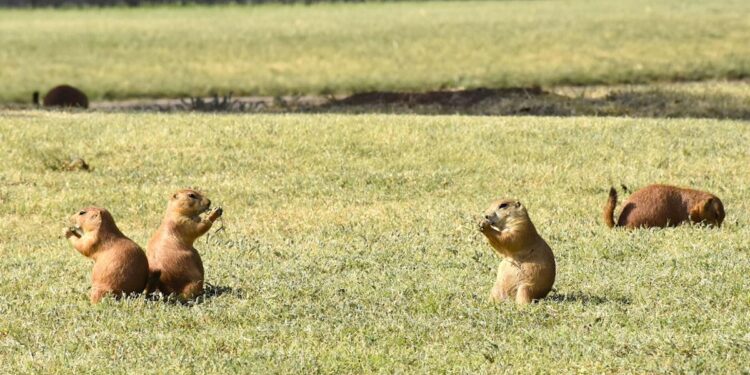Some Lawton prairie dogs will be moved to a country home in the Wichita Mountains Wildlife Refuge, while the remaining colony will be thinned out then confined to a small area of Elmer Thomas Park.
City Council members made the decisions Tuesday, approving the wildlife relocation idea without comment. They did discuss plans to establish a prairie dog town for a smaller colony as part of overall upgrades planned for Elmer Thomas Park. That “town” was one of the ideas outlined in conceptual designs crafted by Halff Associates, hired by the council to develop master plans for multiple recreational sites and activities, including Elmer Thomas Park.
Plans for a confined colony is predicated on continued efforts to thin out the prairie dog population by poisoning them, a program that will continue this fall.
But between 45 and 100 will be moved to the wildlife refuge as part of a plan to re-establish prairie dog colonies there after the refuge lost its colonies in summer 2021. Refuge officials approached the City of Lawton about a partnership that would allow the U.S. Fish and Wildlife Service to coordinate removal of prairie dogs located near Ramada Inn Park, a portion of Elmer Thomas Park on the east side of Northwest 2nd Street. In a letter, wildlife biologist Christine Fallon said the refuge’s long-term goal is to continue prairie dog introduction projects on a larger scale, and that refuge officials know City of Lawton officials want to remove prairie dogs from its park.
The City of Lawton receives a permit from the Oklahoma Department of Wildlife Conservation to conduct its poisoning campaign each fall, and that effort will continue this year, said Interim Parks and Recreation Director Mitch Dooley. City officials say the action is necessary because the prairie dog population is so large, members are migrating to nearby residential properties, school athletic fields and open fields adjacent to Interstate 44. While they are a popular tourist attraction, the prairie dogs also cause extensive damage inside the park by burrowing under buildings and other facilities, and chewing/stripping wiring associated with Holiday in the Park displays.
In its conceptual designs, Halff Associates indicated creation of a prairie dog town in the park’s northeast corner near Lake Helen, a specific area where prairie dogs will be confined. Dooley said naturalists have said the best — and natural — way to confine prairie dogs is tall grass/vegetation: the animals will spread only to areas they can see.
“We’ll let the area grow a little more, naturally,” Dooley said, of plans to have the prairie dog town ringed with tall grass “to act as a barrier.”
“Their world is what they can see,” said Ward 8 Councilman Randy Warren, adding city officials have been informed of that natural barrier plan multiple times over the years.
While he agrees with the natural control concept, Warren had a concern: if the grass is tall enough to act as a natural barrier around the colony, how will visitors see them. Dooley said the area designated for the prairie dog town is a hollow, which means the nearby walking trail is higher and those on it can look down into the colony.
Responding to plans to transfer up to 100 of the animals to the wildlife refuge, Mayor Stan Booker said the number is not enough, adding he is concerned that the burrowing prairie dogs will undermine plans to create new lawn areas within the park for concerts and other events, because of the damage they already are causing.
“We have to understand how to contain them if we’re going to have a lawn,” Booker said.
Want to reach a local audience and grow your business?
Our website is the perfect platform to connect with engaged readers in your local area.
Whether you're looking for banner ads, sponsored content, or custom promotions, we can tailor a package to meet your needs.
Contact us today to learn more about advertising opportunities!
CONTACT US NOW



